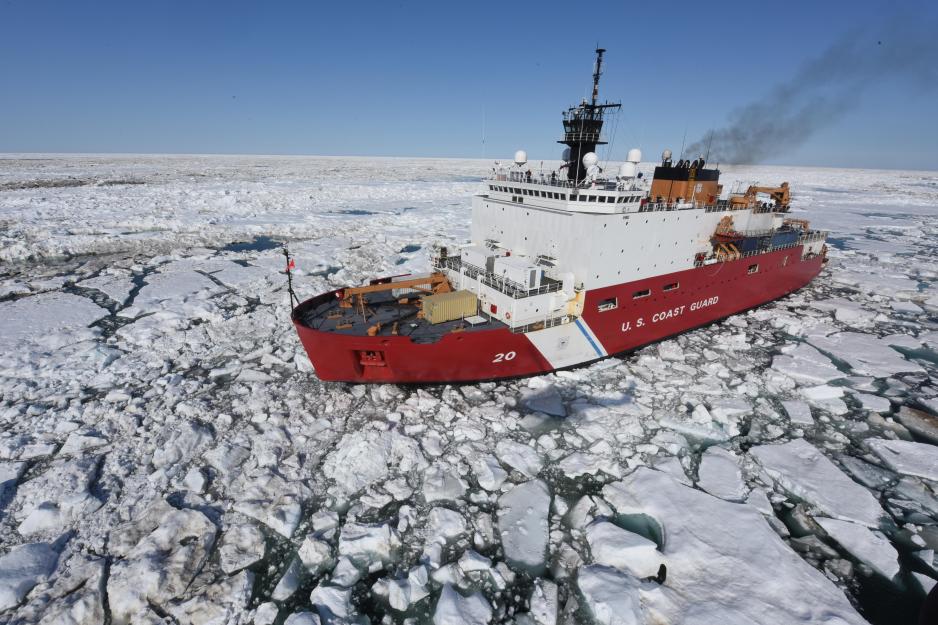U.S. Will Not Increase Presence in Arctic Until 2025

U.S. Coast Guard icebreaker Healy in the Arctic. (Source: U.S. Coast Guard photo by Petty Officer 2nd Class Grant DeVuyst)
The U.S. new icebreaker will only rarely travel to the Arctic, Coast Guard Commandant says. At the same time National Security Advisor says the U.S. will challenge Russia’s military influence in the region. Are the U.S. Arctic ambitions all bark and no bite?
The United States continues to send mixed signals about its anticipated level of engagement and capabilities in the Arctic. The Commandant of the U.S. Coast Guard, Admiral Karl Schultz, cautioned on Tuesday that the new Polar Security Cutter (PSC) icebreaker would primarily be used for scientific missions to Antarctica.
“Until that second or third (polar) security cutter, we won’t really have much of a game up there, in terms of presence,” Schultz told a U.S. House Transportation subcommittee.
This would mean that the U.S. will not be able to increase its surface vessel presence in the region until at least 2025 or even 2027 when the second and third new icebreakers, yet to be funded, are scheduled to be commissioned.
Just a day later U.S. National Security Advisor John Bolton made contradictory remarks about the country’s capabilities during a speech at the Coast Guard Academy.
“With the new PSC, the Coast Guard will lead the way in reasserting American leadership in the Arctic, which has been neglected far too long. These new and innovative tools will enable the Coast Guard to have a year-round U.S. presence in the polar region.”
The United States [will] challenge growing Russian military influence in the Arctic.
Renewed warnings
In his speech Bolton echoed sentiments voiced by Secretary of State Michael Pompeo just two weeks ago at the Arctic Council Ministerial Meeting in Rovaniemi, Finland, warning of Russia’s and China’s activities in the region.
“The United States [will] challenge growing Russian military influence in the Arctic, and push back against China’s illegitimate claim to ‘near-Arctic’ status.”
Experts are not surprised that the U.S’ capabilities will continue to lag behind other Arctic states’ and even non-Arctic states for much of the coming decade.
“Currently, the U.S. is critically limited in access to polar regions by our lack of icebreakers, harming missions important for science and national security,” explains Andrew Holland Chief Operating Office of the American Security Project, a think tank.
But he also pointed out that it was hard to say today what the U.S.’ “national security priorities will be in five or more years when the first icebreaker enters service.”
Also read
Expanding the U.S. Arctic presence
Other experts highlight that the U.S. can increase its presence in the region through other means besides surface vessels. Jim Townsend, adjunct senior fellow at the Center for a New American Security (CNAS), a Washington DC-based think tank, urges to expand the definition of “presence” in the Arctic.
“Presence is more than just icebreakers. We also have to consider the abilities of the U.S. Navy, including aircraft, surface vessels, submarines, and Unmanned Aerial Vehicles (UAVs).”
In fact the U.S. Navy has already taken some initial steps to show an increased presence. The U.S. aircraft carrier Harry S. Truman and its strike group became the first surface vessels in nearly 30 years to travel into the Arctic when they participated in operation “Trident Juncture” off the coast of Norway in October 2018.
The Navy, however, does currently not operate any ice-class vessels and does not have any plans to procure them, limiting their surface operations. In terms of UAVs the U.S. capabilities may also lag behind Russia’s efforts as conventional drones may not be suitable to operate in the Arctic’s very low temperatures or extreme weather conditions.
Russia on the other hand has several Arctic drones under development.
The importance of icebreakers
The importance of icebreakers as a sign of a real presence cannot be ignored, Admiral Schulz confirmed. He emphasized that the Coast Guard operates the country’s only surface vessels capable of venturing into the Arctic Ocean. “In the polar regions, presence equals influence,” he said. “And your Coast Guard is the sole surface presence protecting our rights and projecting sovereignty.”
Even with the second and third heavy icebreaker the U.S. presence in the Arctic may remain limited. As Schulz pointed out, the Coast Guard’s supply missions to Antarctica last more than 100 days leaving little room for additional missions taking into account vessel maintenance and training. Jim Townsend of CNAS confirmed that even with three icebreakers the U.S.’ capabilities for a continuous Arctic presence would be spread pretty thin. “One vessel will be returning from a resupply mission, with the second vessel being readied for a mission, and the third undergoing maintenance.”
Thus, while the U.S.’ political attention has arrived in the Arctic, its actual capabilities will remain largely unchanged for the foreseeable future.




